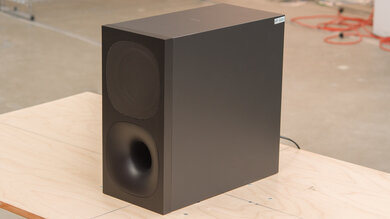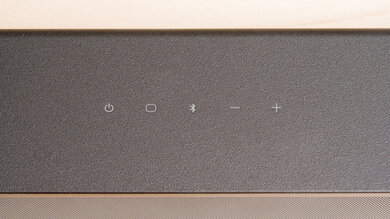The Sony HT-S400 is an entry-level model released as part of Sony's 2022 lineup. It's also available at Costco as the Sony HT-SC40. You'll get built-in support for Sony's S-Force Pro Front Surround technology, which uses psychoacoustic principles to widen the soundstage past the edges of the bar itself, similar to Samsung's Acoustic Beam. There's no Dolby Atmos support to help you enjoy immersive object-based sound common to streaming platforms, though, and you won't find as many features as with Sony's top-of-the-line models.
Our Verdict
The Sony HT-SC40 is okay for mixed usage. It's a simple 2.1 bar that's pretty limited regarding audio format support and sound enhancement tools, so it's best suited for listening to stereo content like music and TV shows. Still, it's a solid upgrade over existing TV speakers, with a clear reproduction of vocals and instruments in your favorite content. The extra emphasis in the high-bass adds some boom to the mix, though it's missing some rumble in the low-bass. Even with its S-Force Pro Front Surround, you still don't get a very immersive feel with surround sound formats like Dolby Digital.
- Gets loud.
- Subwoofer level adjustment.
- Limited sound enhancement features.
- Poor surround sound.
The Sony HT-SC40 is satisfactory for dialogue-focused TV shows and podcasts. With its balanced mids, voices reproduce quite clearly and accurately, and there's even a dialogue enhancement tool called 'Voice' on hand. If you're watching shows at night, you can use the 'Night' tool to balance the volume level between extremes to avoid bothering those around you. There's no center channel, so you don't get the same vocal clarity as with more premium models.
- Dialogue enhancement tool.
- Night mode.
- Limited sound enhancement features.
- No discrete center channel.
The Sony HT-SC40 is fair for music. Its balanced mids offer clear and detailed vocals and lead instruments, making it suitable for listening to most genres. There's also a little extra boom in the upper bass range, so you feel the punch in bass-heavy genres like EDM. Its sub struggles to reproduce lower frequencies, so you don't feel the low bass with the same intensity as other models. Also, there aren't a lot of sound enhancement features on hand.
- Gets loud.
- Subwoofer level adjustment.
- Limited sound enhancement features.
- Lacks low-bass.
The Sony HT-SC40 is mediocre for movies. It supports Dolby Digital, the most common surround sound format found on many different streaming platforms. However, it has to downmix 5.1 surround into stereo to play it, which doesn't sound as immersive. It doesn't support Dolby Atmos or DTS:X, either, so you can't enjoy more immersive object-based formats, which are also quite common on streaming services.
- Gets loud.
- Subwoofer level adjustment.
- No Atmos support.
- Poor surround sound.
Changelog
- Updated Jan 14, 2025:
The Center box has been updated to mention the Samsung HW-B750D.
- Updated May 28, 2024: Updated Stereo Dynamics results with new methodology from TBU 1.3. Added text to Audio Latency: ARC, and Audio Latency: Optical boxes.
- Updated May 27, 2024: We've converted this review to Test Bench Update 1.3. If applicable, we've retested stereo sound based on the manufacturer's recommendations. Additionally, we've expanded our audio latency tests to the following boxes: Audio Latency: ARC, Audio Latency: HDMI In, and Audio Latency: Optical. You can see the full changelog here.
- Updated Jul 06, 2023: Minor text updates to the review for clarity. No changes in test results.
Check Price
Differences Between Sizes And Variants
This soundbar is available in Black. You can see the label for the model we tested here.
There's also a Costco-exclusive version called the Sony HT-SC40. We expect it to perform similarly to this model.
If you encounter another version of this soundbar, let us know in the forums, and we'll update our review.
Popular Soundbar Comparisons
The Sony HT-S400 is a simple 2.1 soundbar that's ideal for stereo content like music and TV shows. That said, it lacks a lot of enhancement tools, even compared to other budget models, so you don't have a lot of ability to control its sound, and there aren't rear speakers available. It's a solid bar, but for the price, other options like the Vizio V Series V51-H6 offer a lot more.
See our recommendations for the best budget soundbars, the best Sony soundbars, and the best soundbars with subwoofers.
The Sony HT-G700 is better than the Sony HT-S400. The HT-G700 is a 3.1 bar with a discrete center channel to improve vocal clarity. Also, it supports Dolby Atmos content, so you can take advantage of more immersive object-based formats often found on streaming platforms. It's better built, too.
The Sony HT-S400 offers an improved performance over the Sony HT-S100F. Thanks to its subwoofer, the HT-S400 can reproduce more low-bass, and overall, its sound profile is more balanced. Its surround performance is better, too, although the bar still downmixes 5.1 content into stereo. That said, the HT-S100F offers a better phantom center channel performance, and it may even be a better choice if you're very low on space since it doesn't have a subwoofer.
The Samsung HW-Q700A is better than the Sony HT-S400. The Samsung is a 3.1.2 bar, and unlike the 2.1 Sony, it has a discrete center channel to improve vocal clarity. Also, it supports more audio formats, such as Dolby Atmos content. There are more sound enhancement features, too, including a graphic EQ to customize its sound.
The Samsung HW-Q600A is better than the Sony HT-S400. The Samsung is a more versatile 3.1.2 bar, with a discrete center channel to help improve vocal clarity compared to the Sony. Unlike the Sony soundbar, it has Atmos support, meaning you can take advantage of object-based formats found on many different streaming platforms. There are more sound enhancement features, too.
Test Results

The Sony HT-S400 has a decent stereo frequency response. The overall sound is pleasing with stereo content, with balanced mids that reproduce vocals and lead instruments with clarity. There's extra emphasis in the mid-to-high bass range, adding extra boom to the mix. The subwoofer is pretty one-note, though—you notice the lack of rumble in the low-bass, especially with bass-centric tracks like EDM.
The Sony HT-S400 gets the closest to a neutral sound profile with its default settings. It is a bit bassy, so you can always use its subwoofer level adjustment feature if you prefer a different sound.
The bar has a decent stereo soundstage. It comes with Sony's always-on surround mode called S-Force Pro Front Surround, which uses psychoacoustics principles to expand the soundstage like similar features from other manufacturers. Sound seems wider than the bar itself, which is good, but it doesn't stretch to the walls of your room. The focus is decent, too, so sound effects seem to come from a more general region than an accurate, pinpoint location in the soundstage.
This soundbar gets loud enough to fill a large room with sound, and there isn't a lot of compression when you push it to max volume. As a result, audio reproduction remains clean and pure, even when you crank up the volume.
Since it's a 2.1 bar, this soundbar doesn't have a discrete center channel to improve vocal clarity. Instead, it uses its left and right stereo channels to simulate a 'phantom' center channel. The resulting sound isn't as clear or as real. Overall, voices are still fairly clear and accurate, though a little muddy due to the extra emphasis in the bass range. Consider a soundbar like the Samsung HW-B750D that includes a discrete center channel for a more realistic and clearer sound.
This 2.1 setup doesn't shine with surround sound, which is by design. It has to downmix 5.1 content like Dolby Digital into stereo in order to play it. As a result, you don't get a very clear or real sound. Audio seems like it's coming from a speaker placed in front of you, rather than from all around your room. The frequency response on these channels is also quite bass-heavy, which adds a boomy, muddy quality to the sound.
It's a simple soundbar without a lot of sound enhancement features. You can adjust its subwoofer levels through the button on the remote that reads 'Bass', but this feature only controls the amount of bass reproduced by the sub, not the bar. The remote also gives you access to its dialogue enhancement mode (called 'Voice') and its night mode, which balances the volume level in your programs. You can't adjust the amount of bass reproduced by the bar, and you can't control the treble. The S-Force Pro Front Surround feature doesn't turn off, either.
This bar has a limited selection of physical inputs. You can connect the bar to your TV over Optical or HDMI, which is nice. However, there's no Full HDMI In for video passthrough, and you can't wire other devices like smartphones with an AUX port.
This soundbar supports Dolby Digital over ARC. Dolby Digital is the most common surround sound format, so you're likely to come across it on most streaming platforms and some Blu-ray discs. However, there's no support for lossless or object-based formats like Dolby Atmos.
Over optical, this soundbar supports Dolby Digital. It's the most commonly-used surround sound format, but since it's a 2.1 bar, it has to downmix it to stereo to play it.
This bar has a fantastic latency performance via ARC. The audio you hear is in sync with the video you see, which is especially great for TV shows with a lot of dialogue. It's worth noting that some apps and TVs compensate for latency differently.
This bar has an okay latency performance over optical. Delay is high whether watching 2.0 PCM or Dolby Digital content, resulting in lip-sync errors. Some apps and TVs compensate for latency, though.
Without a Full HDMI In port, this bar can't serve as a hub between your TV and other devices for video passthrough.
You can wirelessly stream audio to the bar via Bluetooth. If you're an avid Apple or Google user, there's no Chromecast or AirPlay compatibility.




































